Sydney Monorail
| Sydney Monorail | |
|---|---|
 | |
| Overview | |
| Type | straddle-beam Monorail loop |
| Status | Demolished |
| Locale | Sydney |
| Stations | 8 |
| Operation | |
| Opened | 21 July 1988 |
| Closed | 30 June 2013 |
| Owner | Metro Transport Sydney |
| Operator(s) | Veolia Transport Sydney |
| Technical | |
| Line length | 3.6 km (2.2 mi) |
The Sydney Monorail (originally TNT Harbourlink and later Metro Monorail) was a single-loop monorail in Sydney, Australia, that connected Darling Harbour, Chinatown and the Sydney central business and shopping districts. It opened in July 1988 and closed in June 2013.[1]
There were eight stations on the 3.6 kilometre loop, with up to six trains operating simultaneously. It served major attractions and facilities such as the Powerhouse Museum, Sydney Aquarium and Sydney Convention and Exhibition Centre. The system was operated by Veolia.
History

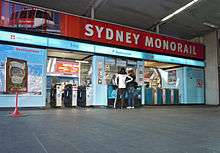
As part of the redevelopment of 50 hectares (120 acres) of land at Darling Harbour it was proposed to build a transport link to the Sydney central business district. Sydney City Council preferred a light rail line, however in November 1985 Transport Minister Laurie Brereton announced a monorail would be built.[2] Initially operated by TNT Harbourlink, the monorail opened on 21 July 1988 after a construction period of 26 months.[3][4] The first test services ran in October 1987 on a 500-metre section at Darling Harbour.[5] TNT Harbourlink was awarded a 50-year concession until 2038.[6]
The original operation hours were to be 06:00 to midnight, but after two years of operation patronage counts were half those expected, and planned stations at Market Street (to be named Casino, as part of the gaming venue planned to be built on the site) and Harbour Street (to be named Gardenside) were not built for some time.[3]
In August 1998 TNT sold the monorail to CGEA Transport Sydney, which was owned by CGEA Transport (later renamed Connex, then Veolia) (51%), Australian Infrastructure Fund (19%), Utilities Trust of Australia (19%) and Legal & General (11%).[7][8]
The Government of New South Wales bought both the monorail and the light rail service from Metro Transport Sydney on 23 March 2012 to enable it to extend the light rail system without having to negotiate with the private owners, and to remove the monorail from the area near Haymarket required for the expanded Sydney Convention and Exhibition Centre.
The monorail ceased operating on 30 June 2013 and all sections of track and some of the stations have been dismantled.[9][10] Around 70 million passenger journeys were made on the line during its lifetime.[11] Two carriages and 10 metres of track have been preserved at the Powerhouse Museum.[12][13] Two carriages are being used as meeting rooms at Google's Pyrmont offices.[14][15]
Technology
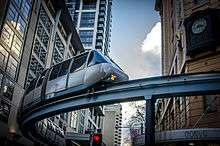
The track was a steel box girder of 94 centimetres width, raised at a minimum height of 5.5 metres from ground level on steel columns 20 to 40 metres apart. The minimum curve radius was 20 metres and the maximum gradient 4.4% uphill and 6.5% downhill.
Power was supplied at 500 V AC to power the train, via a sheathed conductor below the running plate of the track. A control rail was also provided for train control, and a generator provided to clear trains from the track in emergencies. The train control and maintenance facility is located between Convention and Paddy's Market stations, where a traverser moved trains in and out of service.[3]
Each station stop took 40 seconds, including the time to decelerate, board passengers, and accelerate again. A complete circuit of the route took 12 minutes. It was originally intended for the system to operate automatically, but after a number of breakdowns soon after opening, it was decided to retain drivers, who occupied the first car of each train.[3]
Ticketing and concessions
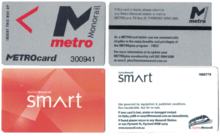
Payment for single journeys was made by tokens inserted into the turnstile. For multiple journeys, customers could purchase pre-paid cards. The first card type was based on magnetic stripe technology and called the METROCard. Shortly before the closure of the Monorail, a new contactless card was introduced called the smart.
Rolling stock
Delivered in 1987, six trains of seven carriages were built by Von Roll Holding to the Type III specification. Each seated 48 passengers, with the driver in the leading car, but were designed to seat 56, using all seven carriages. The first was displayed at the Trans Public Show in Geneva, Switzerland in May 1987.[16]
The monorail trains ran on rubber wheels, and each seven car train had six 37 kilowatts (50 hp) traction motors, permitting a normal operating speed of 33 km/h. The doors of each car were automatic, and the floor level was self-adjusting via an automatic suspension system. Each train was 32.12 metres long, 2.06 metres wide, and 2.6 metres high.[3]
Set 1 was stored following a significant collision between it and Set 4 in early 2010. The last carriage in Set 1 was removed from the set, and used to replace the damaged last carriage in Set 4. When operations ceased in June 2013, sets 2 - 6 were operational.
Stations
The monorail operated in a single counterclockwise loop with stops at the following stations (in order):[17]
| Name | Image | Notes |
|---|---|---|
| Harbourside |  |
Located adjacent to the Harbourside Shopping Centre at the western end of the Pyrmont Bridge |
| Convention | 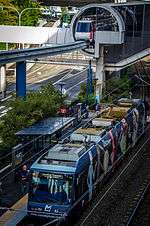 |
Served the Sydney Convention and Exhibition Centre |
| Paddy's Markets | 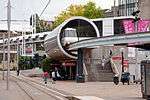 |
Formerly named Powerhouse Museum, and originally Haymarket |
| Chinatown |  |
Located inside the One Dixon Street shopping centre, opened in 2001 as Garden Plaza it closed on 26 July 2004,[18] and then reopened as Chinatown station on 18 December 2006[19] By 2012 the station was unmanned and only open between 07:00 and 09:00 on weekdays only,[20] with the station entrance locked outside these hours[21] |
| World Square |  |
Temporary station in operation until 2005, when the station was rebuilt and incorporated into the new adjacent building |
| Galeries Victoria |  |
Originally named Park Plaza. The temporary entrance provided until 2000, when the station was incorporated into the new adjacent building |
| City Centre | 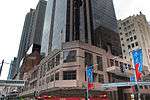 |
A temporary station existed until mid-1989, during construction of the City Centre Shopping Arcade, the temporary station was partially suspended above Pitt Street |
| Darling Park |  |
Originally planned to be named Casino, but Sydney's casino was eventually built in Pyrmont |
Maintenance and control facilities

The six monorail units were maintained in a purpose-built facility in Pyrmont. A traverser allowed monorail cars to be removed from the main track for maintenance or stabling. Maintenance of track and stations was conducted at night with special vehicles, 'Buggy' and 'Mule'.
The facility also housed the Control Room (located above the maintenance area), as well as administration and staff amenities.
Criticism
The decision to build the monorail over other forms of rail (e.g. light rail) was in the eyes of many a political decision. Light rail would have been $20 million cheaper to build, service more passengers per hour and cost 40% less for a ticket, but the monorail system prevailed.[22]
Incidents
On 27 February 2010 at approximately 16:00, two monorail trains collided at the Darling Park station resulting in hospitalisation of four people.[23][24]
On 24 September 2012 just before 14:00, an Ausgrid failure in a local underground cable led to a complete shutdown of the system resulting in the need for cherry-pickers to come to rescue approximately 100 stranded passengers, a process which took several hours. It was the first time since 2000 that Fire and Rescue NSW had to be called to help people from the line.[25]
Removal
Regarding the removal, the Transport for New South Wales released a document called "Monorail Removal Project Interpretation Strategy" in July 2013. In Volume I part 3.5 "Decommissioning the monorail", three quotes from ‘Government Buys Light Rail Company: Monorail To Be Pulled Down’, the media release by Premier Barry O’Farrell on 23 March 2012 are provided.[26]
“This is good news for Sydney - it delivers certainty for business wanting to invest in the Darling Harbour precinct and allows the efficient development of the light rail network,” Mr O’Farrell said.
“The monorail is not integrated with Sydney’s wider public transport network and has never been truly embraced by the community. While it has been a controversial part of Sydney’s history for more than 20 years, the monorail is reaching the end of its economic life and the NSW Government cannot justify costly upgrades like the purchase of new vehicles required to keep it running.
“This decision paves the way for the development of a world class Sydney International Convention, Exhibition and Entertainment Precinct as the NSW Government gets on with the job of making NSW number one again.”

Deputy Mayor of Hobart, Alderman, Ron Christie unsuccessfully asked the NSW government to donate the monorail to Hobart to allow it to be used on a route from the CBD to the northern suburbs.[27][28] Google purchased two carriages for use as meeting rooms at its Pyrmont office.[29][30][31]
The monorail was demolished in 2013.[9] Sixty steel beams were recycled to build a temporary bridge to take Brookhollow Avenue over Norwest station during its construction in 2014.[32]
In January 2015, 22 carriages were put up for sale on Gumtree Australia at $3,000 per carriage.[33] Many of these carriages were subsequently sold to an Australian expat now living in Taiwan. One was sold to a pair of radio hosts. Four, which comprise the only set of carriages preserved with all running gear that includes both a front and a rear carriage as well as middle carriages, other than the full train preserved by the Sydney Electric Train Society, were sold to a Sydney resident who plans to restore them to running condition.[34]
Preservation
Eleven carriages from three of the six monorail trains have been preserved and two carriages converted.[35]
| Monorail Cars | ||||||||
|---|---|---|---|---|---|---|---|---|
| No. | Preserved | Organisation | Location | Status | Ref | |||
| Set 2 | Cars 1+3 | National Transport Museum | Inverell | future static display | [36][37] | |||
| Set 3 | Cars 1+2 | Powerhouse Museum | Ultimo | stored | [13] | |||
| Set 3 | Cars 6+7 | Pyrmont | office meeting room | [38] | ||||
| Set 4 | All Cars | Sydney Electric Train Society | Sydney | future powered display | [39] | |||
In popular culture
The Monorail system was used for scenes in The Saint: Fear in Fun Park and Mighty Morphin Power Rangers: The Movie, where one train set had "Angel Grove" painted on it. It was also briefly featured in the 1999 Australian film Two Hands.
See also
References
- ↑ Last stop for Sydney Monorail Daily Telegraph 23 March 2012
- ↑ "Motorail wins Darling Harbour" Railway Gazette International December 1985 page 901
- 1 2 3 4 5 Churchman, Geoffrey B (1995). Railway Electrification in Australia and New Zealand. IPL Books. ISBN 0-646-06893-8.
- ↑ Pedersen, Kim. "Sydney Monorail Photo Essay – page one of six". Retrieved 20 October 2008.
- ↑ "Monorail's First Tests" Railway Digest December 1987 page 389
- ↑ Sydney Light Rail Extension Stage 1 Inner West Extension Transport NSW July 2010
- ↑ Stock Exchange Announcement Australian Infrastructure Fund 11 August 1998
- ↑ Non-core business TNT Annual Report 1998
- 1 2 "Monorail Removal Project Transport for NSW"
- ↑ Saleh, Lillian (22 June 2012). "Sydney monorail to make its final stop on 30 June next year". Daily Telegraph. Sydney, Australia. Retrieved 25 June 2013.
- ↑ "Transport for NSW Annual Report 2012-13" (PDF). Transpor for NSW. p. 38. Retrieved 14 July 2016.
- ↑ "Sydney's monorail hands $70,000 to sick children as parting gift to city" Daily Telegraph 8 July 2013
- 1 2 "Farewell to Sydney’s Monorail" Powerhouse Museum 1 July 2013
- ↑ "Sydney Monorail becomes Google office space" Special Broadcasting Service 9 October 2013
- ↑ Paul Cowan's Google+ post Google
- ↑ "Metros" Railway Gazette International June 1987 page 357
- ↑ Network & Stations Sydney Monorail
- ↑ "Metro Monorail: Garden Plaza Station Closed". 2004-07-23. Archived from the original on 20 August 2004. Retrieved 1 July 2013.
- ↑ "Metro Monorail: New Monorail Station at Chinatown Means Even More for Sydney Visitors". 2006-12-18. Archived from the original on 20 August 2004. Retrieved 1 July 2013.
- ↑ "Wongm's Rail Gallery: Notice of the limited operating hours at Chinatown station". 23 July 2012. Retrieved 2013-07-01.
- ↑ "Wongm's Rail Gallery: Monorail driver leaves the cab to lock up Chinatown station". 25 July 2012. Retrieved 2013-07-01.
- ↑ Why Sydney Found Itself Looking Up At A Monorail Sydney Morning Herald 29 April 1988
- ↑ McClintock, Alex (28 February 2010). "Four hurt in Monorail collision". Sydney Morning Herald.
- ↑ Saulwick, Jacob (9 May 2011). "Monorail accident ruling". Sydney Morning Herald.
- ↑ Saulwick, Jacob (24 September 2012). "Monorail rescue as power cut". Sydney Morning Herald.
- ↑ "Monorail Heritage Interpretation" (PDF). Transport for NSW.
- ↑ Hobart want our Monorail ABC News 28 March 2012
- ↑ "Hobart wants Sydney's monorail for free,but it won't be a gift". Sydney Morning Herald.
- ↑ Jon Wilson. "Google Sydney office monorail installation". YouTube.
- ↑ Saulwick, Jacob. "Google installs monorail carriages in its office". Sydney Morning Herald.
- ↑ https://plus.google.com/u/0/107519494119268402848/posts/Sfm9SpV4eCE
- ↑ "Monorail leftovers stop road nightmare" Daily Telegraph 12 May 2014 page 7
- ↑ For sale on Gumtree: Sydney's monorail Sydney Morning Herald 4 February 2015
- ↑ Ten Sydney monorail carriages bought for $59,000 will be shipped to Taiwan for potential amusement park Sydney Morning Herald 10 February 2015
- ↑ Harbourlink. "Darling Harbour Monorail Preservation and future Museum". Harbourlink.
- ↑ Monorail coming to town Inverell Times 16 August 2013
- ↑ Museum snares second Monorail carriage Inverell Times 23 August 2013
- ↑ Saulwick, Paul. "Google installs monorail carriages in its office". Sydney Morning Herald.
- ↑ News Sydney Electric Train Society
External links
| Wikimedia Commons has media related to Sydney Monorail. |
- Sydney Monorail
- Harbourlink - Remember Sydney Monorail Web Site
- Monorail Society page on the monorail
- Garry Wotherspoon (2013). "Monorail". Dictionary of Sydney. Retrieved 8 October 2015. [CC-By-SA]